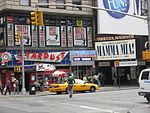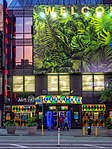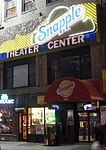Winter Garden Theatre

The Winter Garden Theatre is a Broadway theatre at 1634 Broadway in the Midtown Manhattan neighborhood of New York City. It opened in 1911 under designs by architect William Albert Swasey. The Winter Garden's current design dates to 1922, when it was completely remodeled by Herbert J. Krapp. Due to the size of its auditorium, stage, and backstage facilities, it is favored for large musical productions. It has 1,600 seats and is operated by The Shubert Organization. The auditorium interior is a New York City landmark. The Winter Garden Theatre was adapted from the old building of the American Horse Exchange, completed in 1896. Its original facade consisted of several arches on Broadway, which were subsequently converted to a brick wall with a large sign. The interior is covered with detailing in the Adam style. Though the auditorium contains a single balcony above the orchestra level, the boxes are arranged in two levels above the orchestra. The auditorium contains a ribbed ceiling, which originally had exposed trusses prior to Krapp's renovation. The proscenium and stage also date to Krapp's renovation, when they were scaled down from their original size. The Winter Garden was originally operated by brothers Lee and Jacob J. Shubert. In its early days, the theater frequently hosted series of revues presented under the umbrella titles The Passing Show, Artists and Models, and the Greenwich Village Follies. The Winter Garden served as a Warner Bros. movie house from 1928 to 1933 and a United Artists cinema from 1945 to 1948. Aside from these interruptions, it has largely operated as a legitimate theater. From 1982 to 2013, the Winter Garden hosted only two productions: the musicals Cats and Mamma Mia!. The theater was renovated in 2000 and was known as the Cadillac Winter Garden Theatre from 2002 to 2007.
Excerpt from the Wikipedia article Winter Garden Theatre (License: CC BY-SA 3.0, Authors, Images).Winter Garden Theatre
Broadway, New York Manhattan
Geographical coordinates (GPS) Address Website External links Nearby Places Show on map
Geographical coordinates (GPS)
| Latitude | Longitude |
|---|---|
| N 40.761666666667 ° | E -73.983611111111 ° |
Address
Winter Garden Theatre
Broadway 1634
10019 New York, Manhattan
New York, United States
Open on Google Maps









